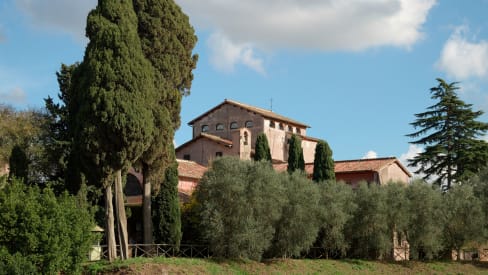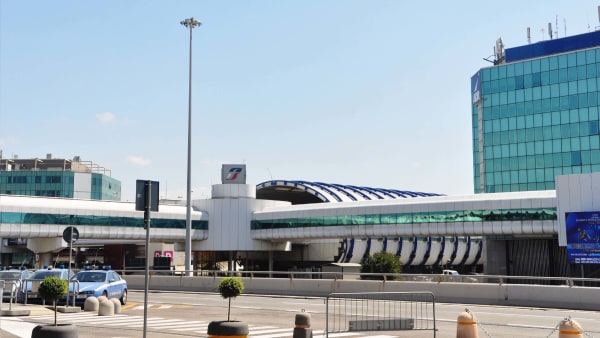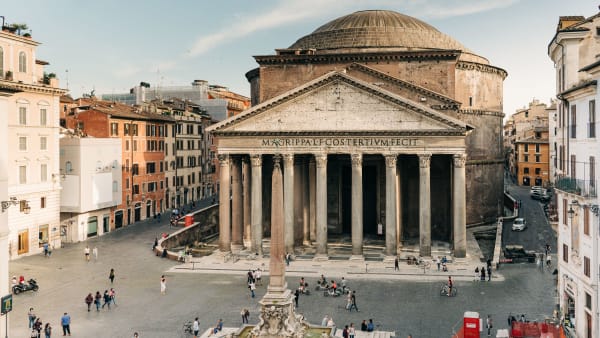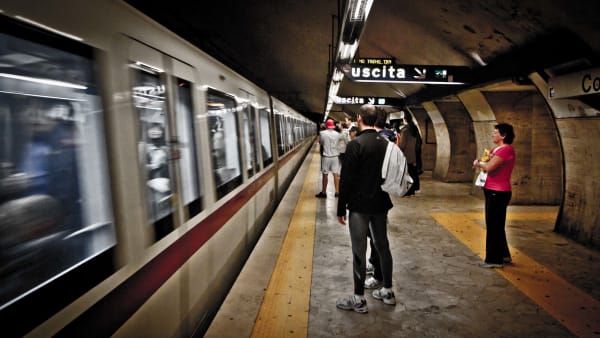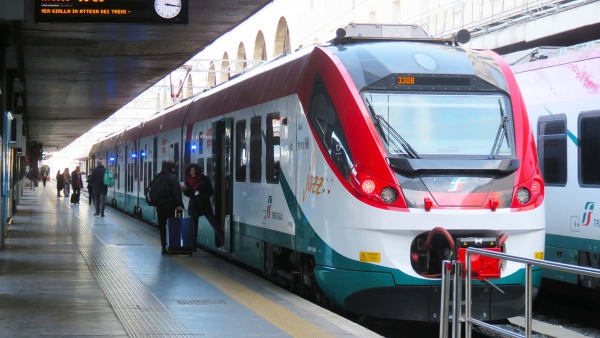Buildings and monuments
Buildings and monuments
As mentioned earlier, the Palatine is full of majestic buildings, works, and monuments from different periods of Roman history. Some of the most ancient and relevant are listed in the historical section of this article and will be detailed below.
Palatine huts
During excavations led by Dante Vaglieri in 1907, foundations of three huts were discovered. These were hidden partly in soil and partly in soft tuff. In 1948, they were more systematically excavated and recorded.
The remains consist of post holes, wall trenches, and drainage ditches delineating three small structures. The best documented was an elongated hut measuring 4.9 m by 3.6 m. The main walls were built with seven posts: four for the corners and three at center positions. There was also a small porch in front, formed by two more poles. In the middle of the hut, there was a fireplace. This hut is also called Casa Romuli or the Cabin of Romulus.
The Palatine huts are similar to other huts of the 9th-7th centuries BC found elsewhere in Rome and at other Latin sites. Based on this evidence, it’s likely that the huts had sloping thatched roofs and walls made of mud, straw, and thatch.
Lupercal
This is a cave on the southwestern slope of the Palatine where a sanctuary was later established and the Romans worshipped the god Luperco.
Located near the walls of Aurelius’ palace, between the Temple of Apollo and the Basilica of St. Anastasia, at the level of the Circus Maximus, the cave is 16 meters deep, 9 meters high, and 7.5 meters in diameter.
It’s thought to be the place where the brothers Romulus and Remus were found by a she-wolf, as described further in Curiosities about the Palatine. According to ancient sources, the place was surrounded by a forest of fig trees, but in the Augustan period, only the remains of a single tree near the Lupercal remained.
Stairs of Cacus
The Scalae Caci or Stairs of Cacus (the giant adversary of Hercules) connected the Palatine to the Forum Boarium before the imperial period through a gateway called Porta Scalae Caci, a square gateway to Rome.
The Porta Scalae Caci was one of three or four entrances (some say even more) that opened into the Roma Quadrata founded by Romulus, around which the original Roman city wall stood.
It’s said that Cassius Longinus (magistrate in 174, consul in 171, and censor in 154 BC) began the construction of a theater. However, the Senate prevented him from doing so because it wasn’t a suitable place for the rough Romans, who were supposed to be engaged only in war and not in entertainment or literature.
Thus, the theater was destroyed, and the remains were left near where the Palatine huts stood. Next to the remains, which date back to 154 BC, are the ruins of the Scalae Caci.
Temple of Apollo Palatinus
Apollo (the god of the sun) was promised the construction of a temple by Augustus (Octavian) if he achieved victory over Nauloco in the important battle against Sextus Pompey in 36 BC.
Apollo’s temple was built on the site where lightning struck Augustus’ estate on the Palatine, an event that, according to the tradition of the time, was taken as a divine sign.
The temple was inaugurated on October 9, 28 BC, 6 years after the vow was made, but the construction had taken some time. Augustus built other temples on the Palatine, but surely the most important and beautiful was the Temple of Apollo (Templum Apollinis). The construction of the latter also became an occasion to celebrate the victory at Actium over Mark Antony.
The temple and nearby library were where the Roman Senate often met during the imperial period. The building was destroyed by a fire on March 19, 363, but thanks to the efforts of rescue workers, the prophecies inside could be saved.
The land on which the temple was built as part of the area where the House of Augustus stood and had been acquired at his expense. The royal palace was connected to the terrace of the sanctuary by corridors decorated with frescoes, according to Hellenistic royal custom, whereby the dynasty was connected to the gods.
Portico of the Danaids
The temple was surrounded by a portico, known as the Portico of the Danaids, with columns of Numidian yellow marble, fifty statues of the daughters of Danaos (a figure from Greek mythology), 50 equestrian statues of their husbands, and a statue of Danaos with drawn sword.
In front of the temple was an altar flanked by bronze statues of Myron’s oxen and a huge marble statue of Apollo (which is not the cult statue), placed on a pedestal decorated with rostrums. Furthermore, the temple stood on an elevation measuring 24 by 45 meters.
The adjacent library, bibliotheca ad Apollinis, according to the Forma Urbis Severiana, consisted of two apside halls, the walls of which were decorated with an order of columns. Not much remains of the Temple of Apollo. The foundation of the podium, part of the cornice, a Corinthian capital, and a small part of the columns can still be admired on the Palatine.
Temple of the Magna Mater (Cybele)
The unfortunate period of the Second Punic War had created a sense among the Romans that they were being persecuted by the gods. Among the various attempts to regain divine grace was the introduction of the cult of the Great Mother (Magna Mater), Cybele, in 204 BC.
To save Rome required the protection of an ancient Mediterranean goddess, the Magna Mater whose important temple existed at Pessinunte, in northern Asia Minor, also known as The Black Stone. The simulacrum was a dark and cone-shaped rock, probably a meteorite.
The temple of Magna Mater (or Cybele) was then built on the Palatine starting in 204 BC and inaugurated on April 11, 191 BC. The celebration kicked off the Ludi Megalensi, a festival in honor of Cybele. The cult was officially proclaimed in the Roman Empire in 160 AD.
The ruins of the temple were found between the archaic huts and the Domus Tiberiana, near the House of Augustus: here the statue of the goddess was also found and the inscription was dedicated to her on the right side of the façade.
The Elagabalium
On the east side of the Palatine is a large, masonry terrace. In the middle of this have been found the remains of the Temple of Elagabel, which overlooked the Via Sacra and the Temple of Venus.
The temple was commissioned by Emperor Heliogabalus, an emperor from Syria who was also a priest of the sun god El Gebal. After coming to power in Rome at a young age, he had his sun god promoted under the Latin name Deus Sol Invictus and commissioned a temple to be built in his honor.
It’s said that the temple expressed a fusion of Roman and Oriental culture through grandiose architecture, columns, and steps of colored marble, beautiful statues, arches, cornices, and capitals.
Inside, it was decorated with painted carpets and pillows, veils of oriental silk, gilded bronze fire pots, and alabaster vases filled with water and floating rose petals.
Temple of Juno Sospita
This temple was built in honor of the Roman goddess Juno, the ruler of the heavens (wife of Jupiter and mother of Mars and Vulcan). The cult for Juno came from the Latin town of Lanuvium, whose inhabitants were granted Roman citizenship in 338 AD. Thus, the Romans adopted the worship of Juno and the first temple was built on the Palatine, which must have had three cells and two rows of columns in the pronaos.
The building probably stood next to the Temple of Magna Mater, where remnants of an ancient temple have been excavated and an antefix with the head of Juno has also been unearthed. The second temple to Juno Sospita stood on the Forum Holitorium.
Temple of Victory
The Temple of Victory was built on the southwest side of the Palatine, dedicated to the Roman goddess Victoria and adjacent to the temple of the Magna Mater. This goddess appears to refer to the Greek goddess of Victory, Nikè.
The temple probably had Greek influences and dates to the 8th century BC, before the founding of Rome. It was made of sun-dried clay bricks, with structural wooden beams for support and a wooden warped roof with steeply pitched slopes.
According to legend, it’s said to have been built by Evander (mythological character), then rebuilt, or built from scratch by Lucius Postumius Megellus, general and Roman politician, with the money from fines he had incurred during his service. The temple was dedicated to the goddess Victoria on August 1, 294 BC, the year he was consul.
The temple was then restored in the late Republic or early Augustan period, possibly before the fire of 3 AD, and later by Caligula.
House of Augustus
Augustus was born on the Palatine and chose it as his residence from the beginning of his political career. This fact was decisive for the future of the hill because since then it became a custom that other emperors also lived on the Palatine.
He bought the house of the orator Hortensius, located next to the so-called House of Romulus which, according to tradition, still existed in 31 BC. He later expanded it by buying adjacent houses and lived there, without turning it into a real palace. Its construction was the result of an assembly of several houses, including that of Caio Lutazio Catulo.
The House of Augustus was built in 36 BC, shortly after the emperor’s victory over the Sicilian territories with Sextus, the son of Pompey. Over time, the residence underwent numerous changes, allowing it to serve different functions than the original.
If we look at the reconstruction of the floor plan of the Domus Augusti, we see an atrium in the middle, a private residence in the left part, and a public part on the right. Noteworthy is an important addition by Augustus: he included the sanctuary of the Lupercal in his house.
The emperor continued to live here until his death and after a lightning strike in the year 3, part of the house was converted into a temple of Apollo. The rooms of the house were decorated with frescoes, large parts of which remain intact today. The complex totaled 12,000 m2 and had two floors.
House of Livia
The House of Livia is located near the Temple of the Magna Mater, on the west side of the hill. It was discovered in 1863 and is one of the few republican houses still standing on the Palatine.
The attribution of the house to Livia Drusilla, the wife of Augustus, dates back to the first excavations carried out by Pietro Rosa on behalf of Napoleon III. Furthermore, it seems to have been an annex of the House of Augustus, with which it was connected.
Inside the villa, the walls are painted with sunny landscapes and beautiful flora and fauna. The first excavations of the site date back to 1863-1864, when the statue of Augustus of Prima Porta was discovered (today found in the Vatican Museums) and some underground rooms, such as the famous hypogeum with garden frescoes.
In 1944, a bomb damaged the underground room, which was also used by the military as a hideout. After the war, it was decided to remove the precious paintings (1951) and transfer them to the National Roman Museum, where they can still be found today.
Domus Tiberiana
The Domus Tiberiana or the House of Tiberius was the first true imperial palace on the Palatine. It was commissioned by Emperor Tiberius and built on the west side of the hill, on a vast site between the Temple of the Magna Mater and the slopes of the Roman Forum. Above it are the 16th-century Farnese Gardens, which cover the remains of the residence of Emperor Tiberius (14-37 AD).
The structure, 150 m long, 120 m wide, and over 20 m high, was the favorite residence of the Antonine emperors, with a library and the imperial archives, which burned down during the reign of Emperor Commodus (176-192 AD).
Inside, it was decorated with frescoes, mosaic floors, precious portals, marble balconies, and columns, among other things. The gardens surrounding it featured statues, fountains, terraces, flower beds, and trees.
The residence was then expanded by Caligula, who directed it to the Forum Romanum, completed by Emperor Nero and later restored by Domitian. Of the central part, only a large peristyle (an open courtyard with garden, surrounded by a colonnade), enclosed by rooms, has survived. From the south side, facing the temple and the House of Livia, 18 rectangular rooms remain, built entirely of brick with vaulted ceilings.
Palace of Domitian
The Palace of Domitian was the most important imperial complex on the Palatine. It replaced several older buildings from Republican to Neronian times, of which underground remains have been found as evidence.
The building consists of three parts:
- The Domus Augustana: the emperor’s private residence;
- The Domus Flavia: the public part of the palace where ambassadors, generals, and other heads of state met;
- The Palatine Stadium: the emperor’s private stadium that was used for recreational purposes.
For the first time, one complex brought together all the functions and needs of the political life of the State, in an organized and efficient manner.
Domus Augustana
As mentioned above, the House of Augustus was the private part of Domitian’s palace. Like the Flavian Palace, it was built during Domitian’s reign (in 85 AD).
The Domus Augustana consists of an eastern wing with a reception hall and basilica, residential quarters, and an imperial bathhouse. It was the private residence of the emperor, “the Augustus”, not Emperor Augustus.
Later it was also the residence and workplace of the highest officials, until the Byzantine period. It was a magnificent building, decorated with marble and fountains, statues, gardens, temples, and beautifully decorated rooms.
Domus Flavia
As mentioned earlier, the western wing of Domitian’s palace, the Domus Flavia, was the public space where the emperor could receive important people and politicians.
It was an almost self-contained rectangular block, extending northward along its entire front and connected to the inner peristyle only by secondary doors.
The rectangular peristyle was the portico that enclosed the garden or courtyard in the center of the house, built with Corinthian columns of precious antique yellow marble. In the center of this structure was a beautiful ornamental fountain, also octagonal.
An important part of this wing was the state residences, arranged on a terrace. Behind it, were two grandiose halls: on the north side the hall known as the Aula Regia, while on the south side was the Imperial Dining Hall.
The first was connected to the peristyle by two doors, between which was an apse in the shape of an arch, with the emperor’s throne in the middle. From this place, he received the homage of all who came to visit him. The Aula Regia was built by order of Nero and then redesigned and completed under the Flavians.
Palatine Stadium
The Palatine Stadium (or Hippodrome of Domitian), as mentioned earlier, was the third and final part of Domitian’s palace built by the architect Rabiro.
The stadium completely enclosed the east side of the Domus Augustana, for a length of about 88 meters. It was a circus-shaped structure, an elongated rectangle measuring about 160 by 48 meters. In the center was a square altar representing the 12 most important gods of Olympus.
The perimeter had a two-story portico consisting of brick columns covered with marble on the lower level and marble columns on the upper level. On the east side, there was a grandstand in the shape of a semicircle at the upper level of the portico in the middle.
Domitian, who was not satisfied with an imperial grandstand at the Circus Maximus, apparently also wanted to build his own stadium for private use. The only imperial family and its guests were allowed to attend.
Its use is still unclear, perhaps it was used as a hippodrome for chariot races, or rides of the emperor. No doubt it was used for recreational purposes, for performances, and as a walking garden for relaxation.
Aula Isiaca
This is an underground room under the so-called basilica auditorium of the Domus Flavia. Discovered in the 18th century, the room must have been part of a complex that extended down the slope of the hill, as evidenced by later finds that revealed other structures connected to the residence.
The room was that of a republican house, decorated at the beginning of the empire in the Augustan period, between 30 and 25 BC with paintings of an advanced style. The original walls to which the Opus reticulatum technique had been applied date from the 1st century BC. Furthermore, the floors were decorated with mosaics.
In the second half of the 1st century BC, an apse with paintings of subjects related to Isis was added on the east side and above it a frieze with Egyptian uraeus (the symbolic cobra snake). The name of the room was eventually derived from the numerous subjects related to the Egyptian cults of Isis and Serapis.
The structure was abandoned in the Neronian period, around the middle of the 1st century AD, when a water reservoir was built on the site, probably by the order of Mark Antony.
House of the Griffin
Under the northern wing of Domitian’s palace, the remains of a republican Domus, the House of the Griffin, were found. This name is derived from a stucco of two griffins located above one of the passageways between two rooms of the complex.
The building is constructed in opus incertum (a mosaic-shaped construction technique applied to walls), with alterations in opus reticulatum (a refinement of opus incertum), with magnificent paintings dating between the late 2nd and early 1st centuries BC (even though the house is older).
Although the residence was interrupted by the foundations of the palaces of Nero and Domitian and therefore only part of it can be seen today, it’s the best-preserved example of a Republican-era residence in Rome.
The house was composed of rooms built on two levels; on the first floor, only the sign of an atrium remains. The owner of the lavish residence is uncertain, although sources speak of wealthy aristocrats from the Republican era.
Domus Severiana
The name Domus Severiana or Casa Severiana refers to an extension of the Domus Augustana, built between the late 2nd and early 3rd centuries by Septimius Severus. The magnificent structure stands on the south side of the Palatine and unfortunately today only brick structures remain of it, stripped of all decorations.
From the stadium, we can see the remaining arches of the Domus Severiana, where Septimius Severus renovated the baths of Domitian and built a large terrace with an imperial lodge, from which one could enjoy the spectacle of the games held below in the Circus Maximus.
The remains of this building are visible only as underground supporting structures, with a double order of vaults with arches supported by brick pillars. This architectural feat allowed the creation of an artificial plane that extended the surface of the Palatine, which by that time had been completely occupied by the other palaces.
The Baths of Septimius Severus, located on the east side of the Palatine Stadium, seems to date from the time of Domitian. He wanted to provide the imperial palace with a bathhouse, as evidenced by the intermediate rooms, most of which are still unexcavated.
The remains of baths, drains and heating systems typical of Roman baths are still visible inside; these show how valuable and rich the interior design was, as evidenced by the capitals and columns on the first floor.
Settizonio
On the southeast side of the hill, overlooking the famous Via Appia Antica, stood the famous Settinozio, built by order of Emperor Septimius Severus.
It’s a majestic nymphaeum facade with columns rising at different levels, and was built to astonish all those who came to Rome along the Via Appia.
The monument was intended as a scenic entrance to the palace, a monumental water structure, which contained statues of the seven planetary deities Saturn, Sun, Moon, Mars, Mercury, Jupiter, and Venus.
Unfortunately, by the end of the 8th century, the Settizonio was already dilapidated, having been converted into a medieval fortress. After the central part collapsed, the remaining ruins became part of the Frangipane system of defenses.
The majestic building was razed to the ground in the 16th century at the insistence of Pope Sixtus V, who decided to use the material stolen here to build several works, including the chapel in the church of Santa Maria Maggiore and the Palazzo della Cancelleria.


